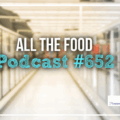I know that you’ve heard about trans fat and that it’s dangerous to your health. It’s a frequent topic of conversation, and now you’ve been seeing the labels in the grocery stating that such and such a product doesn’t contain trans fat (in slightly different wording). Do you know exactly what trans fat is though, and why it isn’t good for your body?
Here is simplified rundown on exactly what trans fat is:
Trans fats are found in partially hydrogenated vegetable oil (Note: fully hydrogenated vegetable oil does not contain trans fat). Vegetable oil is hydrogenated through an industrial process in which the “vegetable oil is reacted under pressure with hydrogen gas at 250 – 400 degrees (F) for several hours in the presence of a catalyst such as nickel or platinum”. The process of hydrogenating the vegetable oil causes it to be a solid at room temperature, provides a certain texture that you notice when you eat foods containing it, and it allows for a longer “fry-life” for cooking oils.
The reason it is called “trans” fat is because the hydrogenation process creates a change in the molecular linkage, placing hydrogen atoms in a “trans” position. When hydrogenated oil is used in processed food (commonly found in baked goods, and even bread), it extends the shelf life of the product up to approximately one year. Again, trans fats are solid at room temperature. An easy way to tell the difference between “good fats” (yes, there are good fats that your body needs) and “bad fats” is that the good fats are liquid at room temperature and get thick when they are cold (example: olive oil). The “bad fats” (whether they are trans or saturated, which is another topic 😉 ) remain solid at room temperature (i.e.: stick margarine, shortening – trans fats, and butter, lard – saturated fats).
The health dangers of trans fat are as follows:
- They lower your HDL (good) cholesterol, which is what clears the gunk out of your system.
- At the same time, they raise your level of LDL (bad) cholesterol, which leads to blocked arteries.
- They stunt your weight loss efforts and are present in the foods that are most associated with long-term weight gain (cookies, cakes, breads, butter, margarine).
Beyond the fact that they will sabotage your best weight loss efforts, they are seriously detrimental to your health, not only causing artery blockage and coronary disease, but also attributing to inflammation (more about this important topic as well as the topic of trans fat can be found in the book YOU On A Diet).
Basically, this stuff is just not natural, and like so many other ingredients and additives that make up processed food today, it doesn’t occur naturally and is not meant for human consumption! Our ancient (healthier than us) ancestors did not consume processed foods; the human body just won’t function at its peak by ingesting them.
Something very interesting that I learned while researching this topic (another fun tid-bit from YOU On A Diet 😉 ) is that trans fat was originally designed for candle wax. When Edison brought us electricity, there wasn’t a market for trans fat anymore; at least, not at that time. 😐





Ah, but be sure your readers understand that butter is not hydrogenated. Nor is lard. Both are natural. Lard is rendered, but it’s not a hydrogenated product.
Hi Beth,
Thanks for your comments! I had that information in my article (re: butter and lard) to illustrate the fact that “bad fats”, whether they are hydrogenated or saturated, remain solid at room temperature. Butter and lard are just as bad for your health as they contain saturated fat, however saturated fat wasn’t the topic of this post, and I can see how that could have been confusing. I reworded it to make it clearer. 😉
Thanks, JoLynn. I was sure that you were illustrating the solid point, but I didn’t want someone to think, “Geez, butter is a trans fat, too? I can’t eat anything!”
Not that butter is great for us, but at least it’s *real*!
Dig your site! Thanks for all the hard work!
Thanks Beth! 🙂
Please note that I’m not recommending butter since it is saturated fat… another “bad fat” (so is lard/animal fat).
The healthiest fats are those that are liquid at room temperature, and become solid when cold. Extra-virgin olive oil, organic (cold-pressed) canola oil, fish, avocados, and walnuts are your healthiest sources of fat to include in your diet. 😉
Nope, not to worry. I know you’re not recommending butter. But given the choice between butter and Crisco, I’d go for the butter, as it’s the lesser of two evils.
I’m all too aware that butter isn’t good for me, sadly!
When I see people I haven’t seen in a while and they comment that I’m thinner, they all ask, enthusiastically, “What are you doing?”
When I say, “Eating better and exercising,” they all say, “Oh.”
I wish I could be healthy on a diet of Cheetos and cheesecake, but alas, I cannot. 🙂
Hi Beth,
That’s so funny, and I can relate soooo much….”I wish I could be healthy on a diet of Cheetos and cheesecake”….so do I! 😆
BTW, congratulations on your weight loss. I read somewhere else (I don’t remember where) about a woman who kept getting the same question…the people asking thought she was doing something special to lose weight, but it just came down to healthy lifestyle changes. 😉
Sorry, I got off topic there (from the butter), but I wanted to let you know I can relate to where you’re coming from. Keep up the great work Beth!